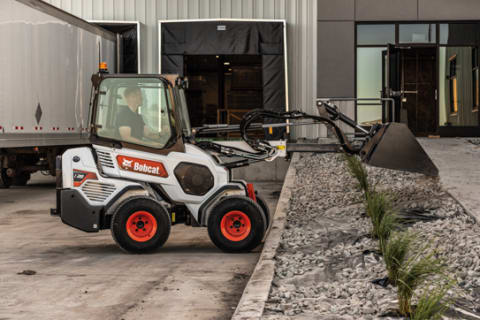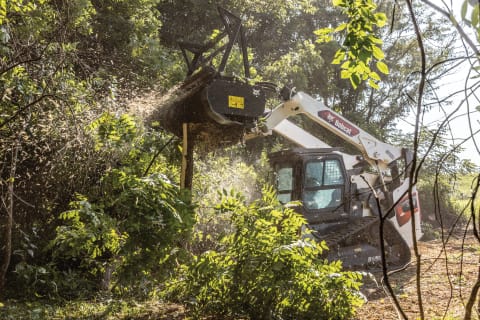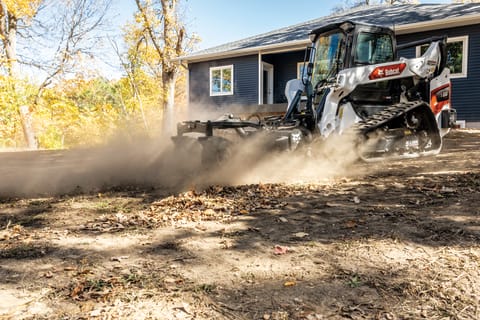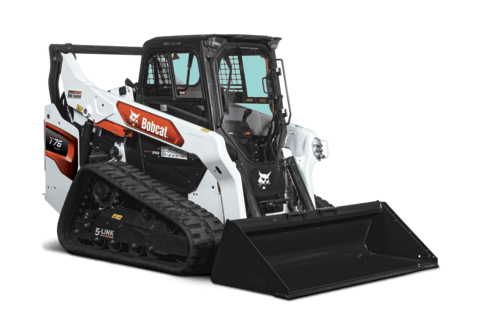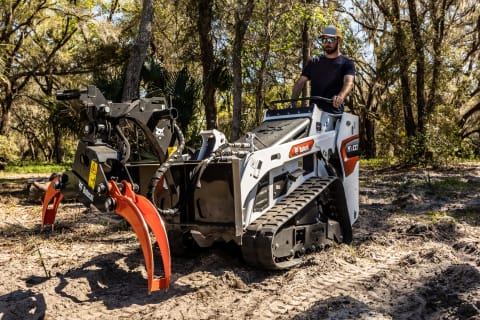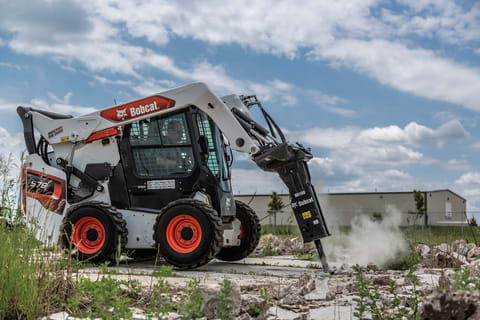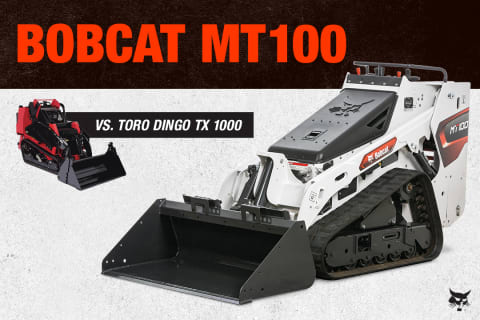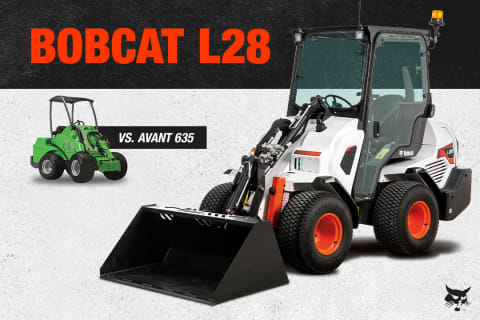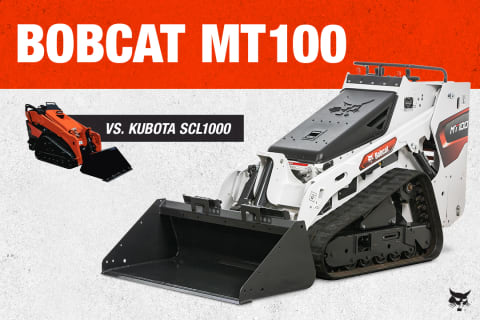- Home
- Buying Resources
- Loaders
- Bobcat T66 CTL vs. Kubota SVL75-2 Compact Track Loader
Build Your Loader, Get a Free Price Quote
Customize your loader. Select the model, choose options, and submit to your local dealer for a free price quote.
Build & QuoteCompetitive Comparison: Bobcat T66 vs. Kubota SVL75-2 Compact Track Loader
Posted on September 1, 2020
There are lots of loaders to choose from; you want the one that works best for you. Let’s compare two popular compact track loaders: the Bobcat T66 and the Kubota SVL75-2.
Summary
If you’re comparing the Bobcat T66 to the Kubota SVL75-2 loader, here are the top things to know:
-
You’ll get 150 pounds more rated operating capacity (ROC) from the Bobcat T66 vs. the Kubota loader.
-
The Bobcat T66 has a faster single speed and Two-Speed than the Kubota SVL75-2.
-
Ultra-responsive selectable joystick controls give you tons of precision in the Bobcat T66 vs. the old-school Kubota controls.
-
There’s a panoramic view from the cab of the Bobcat T66, with clear-side enclosure options, big windows and standard LED headlights. Plus it’s quiet. The Kubota SVL75-2: not so much.
Keep scrolling for a more detailed look at these two models.
Compact track loaders are the small but mighty workhorses of landscaping, construction and agriculture operations. It’s a machine you expect to dig, push, lift, grade and haul anything you throw at it 24/7/365, and pack enough power to take on your ever-bigger projects.
There are lots of loaders to choose from; you want the one that works best for you. Let’s compare two popular compact track loaders: the Bobcat T66 and the Kubota SVL75-2.
Size and Performance Comparison
In terms of horsepower, the Bobcat T66 and Kubota SVL75-2 are evenly matched with 74 turbocharged horses – enough to conquer the track loader’s daily workout regimen of lifts, digs, drags and drops.
Where Bobcat pulls ahead is in rated operating capacity (ROC). At 2,450 pounds ROC, the Bobcat T66 outlifts the 2,300-pound ROC on Kubota’s SVL75-2. To put that 150-pound difference in perspective, that’s an extra five rolls of sod or 2.8 cubic feet of topsoil you can haul.
That adds up over the course of dozens of trips across the jobsite. And here’s one more: A pallet of bricks weighs about 2,430 pounds. The Bobcat T66 can carry that no problem, the Kubota SVL75-2 can’t.
Flotation is a key part of the reason you get a compact track loader, and the Bobcat and Kubota models are relatively evenly matched. The standard-width rubber tracks on the T66 apply a feather-light 5.9 psi, while the standard SVL75-2 floats at 5.8 psi. Both machines reduce troublesome ground disturbance and each can each handle muddy, slick terrain.
Both the Bobcat and Kubota models use a vertical lift-path (vs. radius), so they’re well-suited for loading, material handling and backfilling. And both have the reach to easily dump material into the back of a dump truck.
In terms of working speed, the Bobcat T66 puts the Kubota SVL75-2 to shame. Kubota boasts that two-speed is standard on its loaders (vs. optional on Bobcat models), but Bobcat’s single speed is actually faster than Kubota’s – an energetic 7.2 mph vs. a sluggish 4.9 mph on the Kubota SVL75-2.
If you opt for the Two-Speed Bobcat T66, your max travel speed is a whopping 10.2 mph vs. 7.1 mph on the Kubota loader. Simply put: if you’re operating the Kubota SVL75-2 and trying to keep pace with the working speed of the Bobcat T66, you’d have to run the Kubota at the high-speed setting. That high-speed setting is only meant for traveling across the jobsite, not for digging, lifting, pushing or doing work with the machine.
If you’re working the loader at high-speed, you’ll put a ton of wear and tear on the engine and its components, and may considerably shorten the loader’s life. When it comes to working speed you’ll get more work done faster with the nimble Bobcat T66.
Get a Free Price Quote From Your Local Dealer
Find A DealerControl and Accuracy Comparison
Landscaping projects have grown more complex. They include everything from infinity pools and multi-tiered retaining walls to patios lavish enough to rival any 5-star restaurant. Landscapers have had to up their game, not only the materials they use on the jobsite, but the operators and machines they hire to handle them.
It’s a similar story in the construction space and the agriculture arena too. Precision and control are critical when you’re handling expensive materials and doing finish work. You need a compact track loader with the power of a Clydesdale but the deftness of a hummingbird.
The Bobcat T66 doesn’t disappoint. Its selectable joystick controls are supple and responsive, giving you finite control over every attachment scoop, tip and tilt. And like the steering wheel in your truck, the joystick includes all sorts of other controls you used to find in the dash or console – including speed and horsepower management.
By contrast, the Kubota SVL75-2 uses one-size-fits-all hydraulic pilot controls in a limited ISO pattern. Frankly, the Kubota controls just aren’t as responsive, plus the console switches are spread all around the cab.
Speaking of the cab, the view from the driver’s seat is incredible in the Bobcat T66. Bobcat builds R-Series loader’s arms from cast-steel sections, which gets rid of the clunky weldments you find in other models – including the Kubota SVL75-2 – that annoyingly block the view down to the bucket. And, in the clear-side enclosure option, the T66’s clear glass windows – no mesh on ¾ of the side window! – give you unobstructed, wide views out of the side and down to the tires or tracks.
Comparatively, the SVL75-2’s windows are narrower, have grid covers and the back window is partially blocked by machine components. The difference is like watching a movie in widescreen 5G vs. standard def. – you simply have a better, more expansive view in the Bobcat T66.
One more thing about visibility: LEDs. The Bobcat T66 loader comes standard with ultra-bright LED headlights. The LED headlights are perfect for nighttime roadwork, early morning construction jobs, low-light barn conditions and late night conditions.
Bobcat also offers an optional LED side lighting kit to further boost visibility. The kit provides bright, far-reaching illumination with a minimal power draw, and it’s integrated with the machine design to protect against debris. By contrast, the Kubota SVL75-2 loader uses dimmer halogen headlights.
Loader Attachments Comparison
Both the Bobcat T66 and Kubota SVL75-2 offer many loader attachments, which is pretty standard for any machine on the market today. But one noteworthy comparison between the Bobcat T66 and the Kubota SVL75-2: attachment leveling.
Both the Kubota and Bobcat models provide some automatic bucket-leveling capabilities. The Kubota SVL75-2 self-leveling system keeps the attachment level as the loader arms lift up. However, the system doesn’t maintain level on the way down.
The Bobcat T66 dual-direction bucket positioning controls the level as the arms lift and lower. That’s an important consideration if you want to minimize spillage.
Plus, the Bobcat model comes with automatic ride control, which cushions the attachment when you’re transporting material across the jobsite and reduces the chance of spills. As a bonus, optional automatic ride control also makes for a butter-smooth ride in the machine too (a feature Kubota doesn’t offer).
Operator Comfort Comparison
The beauty of a track loader vs. a wheeled skid-steer loader is that it practically glides over rough terrain. Both the Bobcat T66 and Kubota SVL75-2 provide a relatively even ride, although the 5-Link torsion suspension of the T66 feels smoother.
In terms of interior comfort, there are stark differences between the Bobcat T66 and the Kubota SVL75-2. Step inside the Bobcat loader and right away it feels more modern.
The T66 operates like a command center inside, with keyless start and intuitive displays within your line-of-sight. By comparison, the Kubota cab feels more dated, and the placement of the roll-up door makes it awkward to find some of the displays.
Also, the one-piece pressurized cab seals tight to block out dust and debris. Unfortunately, the same can’t be said for the SVL75-2 cab, which uses a two-piece construction and has a pull-down door that rattles. Kubota also features an analog display in its loader. The Bobcat boasts a full-color 5-inch LCD display that’s rear-camera ready.
Request a Demo From Your Local Dealer
Request a DemoMaintenance and Service Comparison
Running daily maintenance on your loader should be as easy and routine as brushing your teeth, and the Bobcat T66 is. The cab tips back easily, giving you unobstructed access to the engine compartment.
A service panel on the side of the machine puts components in easy reach. And the digital display inside gives you an easy-to-understand explanation of any machine issues.
Unfortunately, running routine maintenance and service on the Kubota SVL75-2 isn’t as easy. The cab doesn't tilt back as far and there are many hydraulic lines and hoses in the way.
The Bobcat T66 features a powerful cooling system, further decreasing the chance of components overheating or encountering service issues. But if you do run into anything, Bobcat has North American parts distribution, so there’s little wait time.
Kubota uses imported parts for its machines, which can be impacted by a number of factors that can leave your machine in the shop for days or weeks at a time.
In addition, the Kubota SVL75-2 uses a diesel particulate filter (DPF) system, which can lead to expensive maintenance costs. The Bobcat T66 doesn’t use a DPF, so it has lower overall maintenance costs and you don’t have to factor in downtime for replacing it.
Choose The Right Compact Track Loader For You
Your loader should work as hard or harder than you do. If you’re buying a new compact track loader, it’s important to consider the differences in not only size and performance, but also how different loaders measure up in terms of control and accuracy, comfort and maintenance needs.
There are some similarities between the Bobcat T66 loader and Kubota SVL75-2, and some important differences too. One of the best ways to pick the right machine for you is to give it a test run.
Use the Build & Quote tool to configure your dream T66 and connect with a dealer today, plus download this spec chart for a quick comparison of the Bobcat T66 vs the Kubota SVL75-2.
Explore More Loader Resources
View All Articles- Small Articulated Loaders Productivity for Grounds Maintenance
Small Articulated Loaders Productivity for Grounds Maintenance
Learn about how versatile and powerful small articulated loaders increase productivity and their advantages for ground-maintenance and landscaping professions. - How Compact Loaders are Beneficial for Forestry Work
How Compact Loaders are Beneficial for Forestry Work
Learn how Bobcat compact track loaders and skid-steer loaders provide versatility with attachments and machine power to increase your productivity for forestry work. - Landscaping Attachments for Compact Loaders
Landscaping Attachments for Compact Loaders
Explore the top landscaping attachments for your compact loaders, like compact track loaders for versatile productivity and power on the job. - Section 179 Tax Deduction for Compact Equipment
Section 179 Tax Deduction for Compact Equipment
Leverage IRS Section 179 for small business tax benefits to deduct the full purchase (or lease) on qualifying compact equipment during the tax year. Learn more. - Top Attachments for Mini Track Loaders
Top Attachments for Mini Track Loaders
Discover the top attachments from the 24 available for the Bobcat Mini Track Loaders for job-specific landscaping, grounds maintenance and forestry challenges. - Bobcat Attachments for Concrete Work with Compact Loaders
Bobcat Attachments for Concrete Work with Compact Loaders
Learn why Bobcat loaders are the machines of choice for concrete contractors with the productivity increase of Bobcat attachments specifically for concrete work. - How to Choose Compact Track Loader Tracks
How to Choose Compact Track Loader Tracks
The right compact track loader tracks can improve your machine’s performance, minimize ground disturbance and extend your working season in wetter months. - Bobcat MT100 vs. Toro Dingo TX 1000
Bobcat MT100 vs. Toro Dingo TX 1000
When choosing a mini track loader, it is important to examine key features and benefits. Explore how the Bobcat MT100 stacks up against the Toro Dingo TX 1000. - Bobcat L28 vs. Avant 635 Small Articulated Loader
Bobcat L28 vs. Avant 635 Small Articulated Loader
Small articulated loaders provide impressive lifting capabilities. When looking at the Bobcat L28 compared to the Avant 635, here are some factors to consider. - Bobcat MT100 vs Kubota SCL1000
Bobcat MT100 vs Kubota SCL1000
Every feature and specification matters, to obtain maximum production and output from a mini track loader. Compare the Bobcat MT100 against the Kubota SCL 1000.
